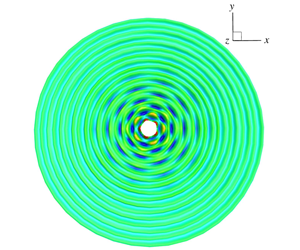No CrossRef data available.
Article contents
Instability of finite-amplitude gravity–capillary progressive ring waves by an oscillating surface-piercing body
Published online by Cambridge University Press: 28 January 2020
Abstract

We investigate the instability of finite-amplitude progressive ring waves in deep water, which are radiated by the time-periodic oscillation of a half-submerged sphere (with radius  $r_{1}$), under the influence of gravity and surface tension. We use direct numerical simulations of fully nonlinear wave–body interactions to quantify the temporal–spatial evolution of the base and perturbed outgoing ring wave fields, from which the stability of ring waves is analysed. The numerical simulation is based on a mixed Euler–Lagrangian quadratic boundary-element method and accounts for fully nonlinear wave–wave and wave–body interactions in the context of potential flow. We find that the progressive gravity–capillary ring waves (with frequency
$r_{1}$), under the influence of gravity and surface tension. We use direct numerical simulations of fully nonlinear wave–body interactions to quantify the temporal–spatial evolution of the base and perturbed outgoing ring wave fields, from which the stability of ring waves is analysed. The numerical simulation is based on a mixed Euler–Lagrangian quadratic boundary-element method and accounts for fully nonlinear wave–wave and wave–body interactions in the context of potential flow. We find that the progressive gravity–capillary ring waves (with frequency  $2\unicode[STIX]{x1D714}_{0}$) become unstable to (small-amplitude) radial cross-wave disturbances when the body-motion parameter
$2\unicode[STIX]{x1D714}_{0}$) become unstable to (small-amplitude) radial cross-wave disturbances when the body-motion parameter  $k_{0}a$ exceeds the threshold value
$k_{0}a$ exceeds the threshold value  $\unicode[STIX]{x1D700}_{c}$, where
$\unicode[STIX]{x1D700}_{c}$, where  $a$ is the amplitude of body oscillation and
$a$ is the amplitude of body oscillation and  $k_{0}$ is the wavenumber of the ring wave at subharmonic frequency
$k_{0}$ is the wavenumber of the ring wave at subharmonic frequency  $\unicode[STIX]{x1D714}_{0}$. The predicted
$\unicode[STIX]{x1D714}_{0}$. The predicted  $\unicode[STIX]{x1D700}_{c}$ from nonlinear simulations under the assumption of ideal fluid, which decreases with increasing
$\unicode[STIX]{x1D700}_{c}$ from nonlinear simulations under the assumption of ideal fluid, which decreases with increasing  $k_{0}r_{1}$, is generally smaller than the experimental measurement of Tatsuno et al. (Rep. Res. Inst. Appl. Mech. Kyushu University, vol. 17, 1969, pp. 195–215) by approximately 50 %. When the viscous effects in body-surface and free-surface boundary layers are taken into account, the predicted
$k_{0}r_{1}$, is generally smaller than the experimental measurement of Tatsuno et al. (Rep. Res. Inst. Appl. Mech. Kyushu University, vol. 17, 1969, pp. 195–215) by approximately 50 %. When the viscous effects in body-surface and free-surface boundary layers are taken into account, the predicted  $\unicode[STIX]{x1D700}_{c}$ matches the experimental data excellently. The unstable modes are characterized as the progressive radial cross-waves at the subharmonic frequency (
$\unicode[STIX]{x1D700}_{c}$ matches the experimental data excellently. The unstable modes are characterized as the progressive radial cross-waves at the subharmonic frequency ( $\unicode[STIX]{x1D714}_{0}$) with the growth rates generally increasing with
$\unicode[STIX]{x1D714}_{0}$) with the growth rates generally increasing with  $k_{0}a$. The maximum growth rate is achieved for the cross-wave mode with the azimuthal wavenumber
$k_{0}a$. The maximum growth rate is achieved for the cross-wave mode with the azimuthal wavenumber  $m^{\ast }\sim 1.2k_{0}r_{1}$. These distinctive features of instability obtained in numerical simulations are consistent with the experimental observations. From the comparison with the weakly nonlinear analysis of Shen & Liu (J. Fluid Mech., vol. 869, 2019, pp. 439–467), it is found that inclusion of finite-amplitude ring wave effects generally reduces the growth rate of unstable modes but has an insignificant influence on the shape of unstable modes and the value of
$m^{\ast }\sim 1.2k_{0}r_{1}$. These distinctive features of instability obtained in numerical simulations are consistent with the experimental observations. From the comparison with the weakly nonlinear analysis of Shen & Liu (J. Fluid Mech., vol. 869, 2019, pp. 439–467), it is found that inclusion of finite-amplitude ring wave effects generally reduces the growth rate of unstable modes but has an insignificant influence on the shape of unstable modes and the value of  $\unicode[STIX]{x1D700}_{c}$. Moreover, for moderately steep ring waves, nonlinear interactions of a few unstable modes can excite broadbanded unstable subharmonic cross-wave modes, leading to the formation/observation of distinctive non-axisymmetric wave patterns during long-time evolutions.
$\unicode[STIX]{x1D700}_{c}$. Moreover, for moderately steep ring waves, nonlinear interactions of a few unstable modes can excite broadbanded unstable subharmonic cross-wave modes, leading to the formation/observation of distinctive non-axisymmetric wave patterns during long-time evolutions.
JFM classification
- Type
- JFM Papers
- Information
- Copyright
- © The Author(s), 2020. Published by Cambridge University Press




